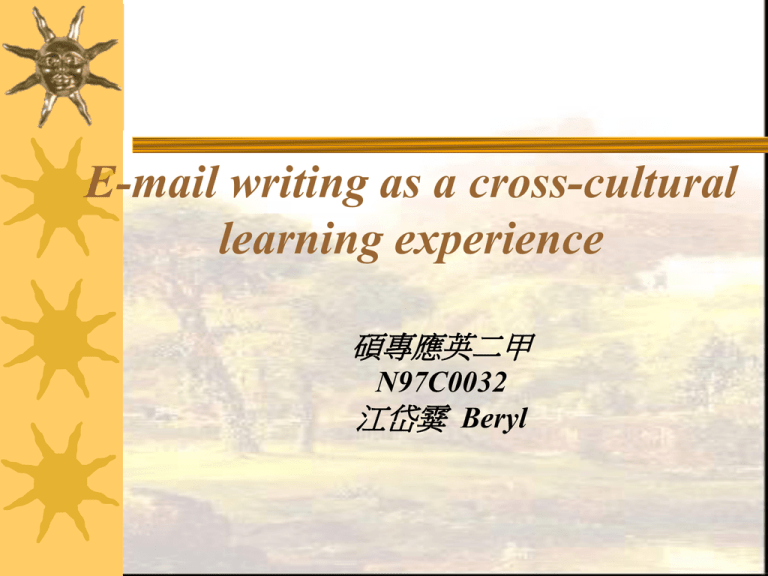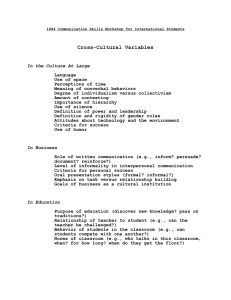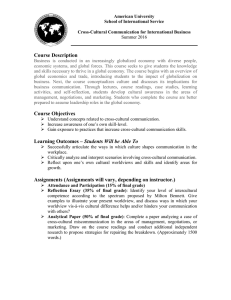E-mail writing as a cross-cultural learning experience 碩專應英二甲 江岱霙
advertisement

E-mail writing as a cross-cultural learning experience 碩專應英二甲 N97C0032 江岱霙 Beryl Introduction Cultivating international understanding, responsibility, and effective particiption in a global age(Kramsch, 1991, p.221) Robin-Stuart and Nocon(1996) categorize the different theoetical perspectives regarding how culture is acquired in a foreign language classroom: (1) culture as an automatic outcome of language instruction; (2)culture as knowledge or skills that may be objectified ; (3) culture as meaning making process The first, and probably the more traditional, view assumes that language study itself can automatically lead to cross-cultural understanding; even without any specific treatments designed to promote intercultural understanding and instruction, language study and performance per se will automatically open the door to another culture and to shared understanding. The second view:culture as facts to be learned and stored; culture is regarded as a list of facts to be cognitively consumed in the development of a knowledge base The third perspective, and the most recent one, views culture as ``a way of perceiving, interpreting, feeling, being in the world, wanting to smile, wanting to scream, loving, hating, and relating to where one is and who one meets'' (Robin-Stuart and Nocon, 1996, p. 432). Introduction The study of culture became an important aspect of foreign language teaching that is oriented toward communicative proficiency of foreign language teaching that is oriented toward communicative proficiency (Omaggio, 1986). Culture learning and teaching progress from defining culture as the best in human life to everything in human life (Brooks, 1975; Seelye, 1974) The use of Internet, especially e-mail writing, has certainly brought together students of different languages and e-mail writing, has certainly brought together students of different languages and cultures to interact with one another in ways that were not possible before. Context and purpose of the study Many Chinese EFL teachers recognize the need to include cultural learning in their classes in order to EFL teachers recognize the need to include cultural learning in their classes in order to strengthen learners' communicative competence (Hu, 1990; Zheng, 1990) The goals for the pre-service teachers (1) cultivate students' understanding through inquiry, discussion, and comparison of cultural information (2) develop sensitive ways of improving their communication with non-native speakers of English (3) examine ways that internet communications can enhance their future teaching This research was conceived of as a descriptive study of how cultural exchange occurs in a minimally directed environment using e-mail in which the research goal was to achieve a better understanding of how cross-cultural interaction evolves in the naturalistic Internet setting. Method Participants First semester 1 class- 22university EFL freshman students in Taiwan 2 classes- pre-service ESL teacher at Texas A&M University Second semester (cross-cultural e-mail project) • • 13 Tunghai University students 1 class BIlingual/EFL pre-service teachers at Northern Arizona University in Yuma Third semester (corresponded) • • 21 Tunghai University students 1 class BIlingual/EFL pre-service teachers at Northern Arizona University of Houston Downtown Method Procedures Preparation -At the beginning of each semester, two 50-minute computer lab training sessions to familiarize the use of e-mail pro- lab with a technical assistant to familiarize the students with the use of e-mail procedures. -The students were trained to use the mail application of the Pine/C-Pine cedures. -Students send short messages to the instructor/researcher. A short message was sent in response to the student to confirm successful transmissions. The students who did not receive a confirmation had to report to the instructor and retry the transmission until everything was well set up. E-mail to cross-cultural partners Method Data collection and analysis • Data collection (1) the e-mail entries written by the Taiwanese university students; (2) the e-mail entries written by the preservice teachers at the three USA universities; (3) the written reports by the participants The notes were further analyzed to reveal information about howstudents overcame communication barriers Obtain the participants’ reactions toward the culture learning experiences Findings Recurring cultural themes • • • • • • • Geographocal information Holiday celebrations School systems Names History, language, and religion Interpersonal relationships Current events Familiar content served as an essential ingredient in introducing new concepts Findings Effects of cultural assumptions and values on communication effectiveness • Cultural perspectives sometimes converge and sometimes diverge in unexpected ways. • Cultural differences hindered effective communication, other times they caused the participants to strive for the means to bridge he gaps. Discussion and conclusions This cross-cultural e-mail approach enabled the participating students to form their own cultural images of the target culture through on-going interpersonal interaction. The cultural themes that occurred in the exchanges included geographical information, holiday celebrations, school systems, names, history, languages, religions, interpersonal relationships, and current events. Pfister and Borzilleri (1977) suggest an inventory of cultural topics for curriculum design to include (1) the family unit and personal sphere, (2) the social sphere, (3) political systems and institutions, (4) the environmental sphere, and (5) religion, the arts, and the humanities Find a way to promote better cross-cultural understanding while continuing to develop linguistic skills Discussion and conclusions intercultural communication that contributed to their personal affective development as well as to the development of a more receptive group of language learners. being tied to the traditional ``do as the teacher does'' or ``do as you see and hear native speakers doing'' foreign language learner positions cultivate a deep appreciation of other countries, their cultures, and their people understanding and acceptance of other cultures are key pedagogical aims for foreign language education. EFL teachers can take full advantage of this modern day technology to change the way culture has been instructed in the classroom


